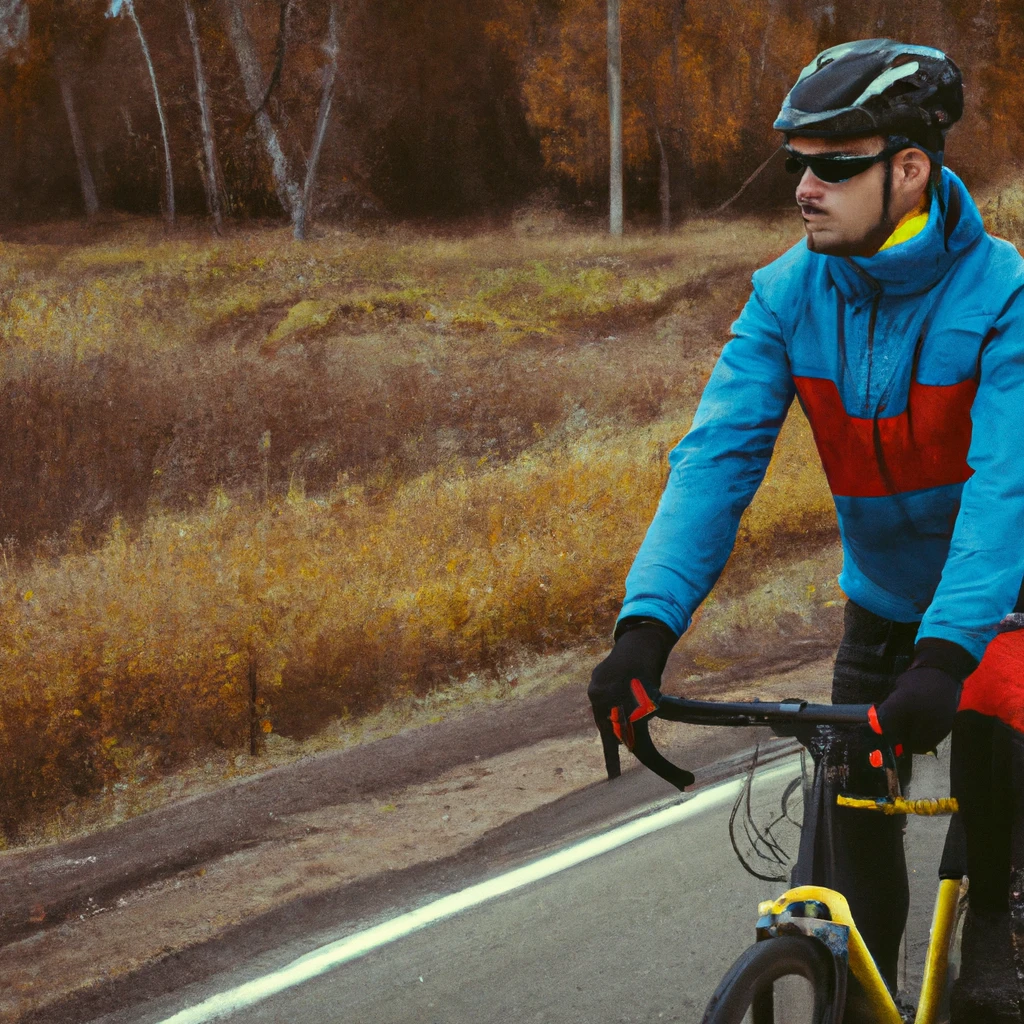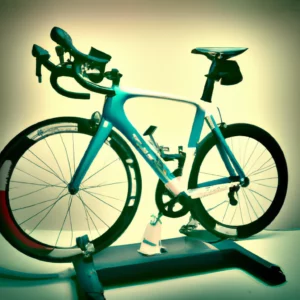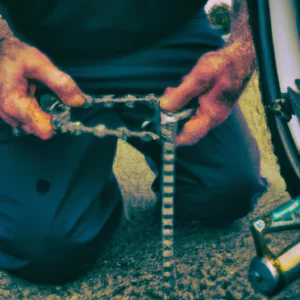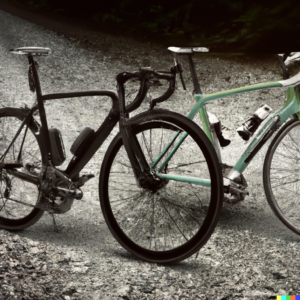When you think of autumn cycling, what’s the first image that springs to mind? Is it the vibrant kaleidoscope of oranges, reds, and yellows reflecting in the morning mist, or the thrill of pedalling briskly through a crisp carpet of rustling leaves? Or perhaps, it’s the gentle warmth of the soft autumn sun as it breaks through the cool air, casting long, loping shadows along your trail. Just the thought of those sensations can make one itch for a good bike run, right?
Cycling in autumn possesses a certain allure that’s not found in other seasons. It’s a mix of the serene tranquillity of the nature around you, and the exhilarating challenges that come with the changing elements. The temperature begins to drop, the days grow shorter, and the weather becomes a tad unpredictable (is that the charm of a light drizzle or the sting of a sudden shower on the horizon?). With these shifting conditions, one must adapt accordingly to fully savour the beauty of the season.
The sensory delight of autumn cycling
Autumn offers unique sensory experiences that every cyclist can appreciate. Picture the burnished beauty of the trees framing your journey, with leaves tumbling gently in the breeze. The air smells fresh, earthy, and inviting; with each breath you take, you’re truly partaking in a season in flux, a revival of sorts. Autumn cycling not only captures the senses, but it also fuels an inner revival. The ebbing heat of summer is replaced with cool, fresh winds that invigorate your body with every pedal stroke. Isn’t that what sets cycling in autumn apart?
Embracing the unpredictability of the season
Let’s not forget much about autumn cycling is about embracing the unpredictable weather it brings with it. The day can start with clear blue skies and mellow warmth, descend into wind-swept coolness in the afternoon, and finish with the refreshing (or perhaps not so refreshing) surprise of an evening drizzle. Each ride is a rollercoaster of conditions, demanding your adaptability and resilience, before rewarding you with a burst of gratification. It holds the promise of adventure at every turn. And isn’t that why we love cycling, after all?
Getting the most out of autumn cycling
Whilst autumn cycling can be a delightful experience, it does require a little bit more preparation compared to the carefree rides of summer. The right cycle wear is essential not only for your comfort and safety (because no one enjoys being wet and cold), but also for improving your overall cycling experience. By gearing up appropriately, you can fully embrace and immerse yourself in the beauty of your environment. And trust us, with the colours and sensations autumn offers, it’s an environment worth immersing in.
So, are you ready to embark on an autumn cycling journey? Let’s dive into how to ensure you’re prepared to take full advantage of this magical season on wheels. It’s time to gear up, pedal on and fall in love with autumn cycling (if you haven’t already)!
Why Dressing Right for Autumn Cycling Matters: The Importance of Comfort and Safety
As a life-long cyclist, I’ve been through all the seasons several times over. When autumn rears its gorgeous, golden head, I know it’s time to rethink my cycling wardrobe. This season brings with it some distinct challenges and rewards when it comes to keeping comfortable and safe on the saddle.
“Above all, autumn cycling is about being prepared. Think ahead, layer up, and don’t let the unpredictable weather catch you off-guard.”
Experience Taught Me the Importance of Layering
In my early days of autumn cycling, I’d often end up uncomfortably cold or overly sweaty. It took me a while to realise the art of layering. Doubling up your clothing allows you to adjust to changes in temperature and weather conditions.
- Start with undershirts and leggings that wick away moisture. They’re made of materials that keep you dry, which is vital when temperatures fall.
- Wear a windproof jacket on top to protect against the cool breezes. Remember, wind resistance increases significantly when cycling, which magnifies the cold.
- Consider wearing thermal gloves and hats. We lose a lot of body heat from our extremities, so it’s essential to keep them warm.
Exercising Caution and Safety – Visibility Matters
A significant part of autumn cycling—and especially dusk cycling—is ensuring you’re seen by drivers and pedestrians. As the days get shorter and visibility reduces, I often up my safety game to stay seen.
- Choose clothes with reflective elements – they’re often subtly woven into the fabric, and they’re irreplaceable when it comes to being seen after dark. You’d be surprised at just how much difference it can make.
- Invest in bike lights, if you have not already. Mount them on both the front and back of your bike. Remember, they’re not just for your vision, but to allow others to see you.
| Element | Description |
|---|---|
| Undershirts and leggings | Moisture-wicking materials to keep you dry. |
| Windproof Jacket | Protects against chilly breezes whilst cycling. |
| Thermal gloves and hats | Keeps extremities warm where much body heat is lost. |
| Reflective elements | Improves visibility to other road users. |
| Bike lights | Illuminate the road and make the cyclist more visible. |
From personal experience, dressing right makes a world of difference to autumn cycling. With the right gear and a little preparation, there’s no reason it can’t be one of the best seasons to enjoy cycling.
Layering Up for Autumn Rides: How to Stay Warm Without Overheating
Pulling on my trusty fleece-lined arm warmers and selecting the perfect autumn bike kit can be more tasking than one might anticipate. The key is all about finding the right balance. When I set out for my brisk morning ride, my primary goal is always to avoid the dreaded chill that autumn winds bring, but equally important is to prevent overheating after intense pedalling. How do I achieve this perfect equilibrium, you ask? It’s simple: Layering!
Importance of Layering
To effectively cycle in the autumn, I discovered (and many other cyclists will attest to this) that layering is crucial. Layering offers the flexibility to add or remove clothing as needed, allowing you to remain comfortable and focus on the road more than your potential discomfort.
“Layering is like an onion: multiple layers of cycling clothing that can be peeled off or added on to help maintain the right body temperature. It’s an art, but luckily, an art we can all master.”
What Are the Essential Layers for Autumn Cycling?
Let’s delve into the layers you’ll need to assemble your perfect autumn cycling wardrobe.
- Base Layer: This layer is closest to the skin and its primary function is to wick away any sweat. I prefer base layers made from synthetic materials or merino wool, as they provide fantastic moisture-wicking properties.
- Middle Layer: Experimenting with different materials and weights has led me to discover that a long-sleeved jersey is perfect for the autumn months, offering just enough insulation without causing overheating.
- Outer Layer: A lightweight, windproof jacket is my go-to when facing the unpredictable autumn weather. It’s like the shield of my autumn armour, protecting me from wind and occasional drizzle without adding unnecessary weight.
Additional Tips For Layering
- Always opt for materials with good breathability. This allows excess heat to escape, preventing overheating.
- Invest in quality cycling clothing. Trust me, it not only lasts longer but also provides superior comfort and performance.
- Do not overlook accessories like neck gaiters and gloves. They often make the difference between an enjoyable ride and a miserable one in autumn.
“Proper layering may take time and practice to perfect, but it’s an investment worth making. After all, our comfort, performance, and joy of riding depend on it.”
Autumn cycling can be a beautiful and enjoyable experience, if done right. And, remember, it’s not about the most expensive kit on the market, but about the right kit for you and the elements you’ll be facing. With these guidelines and some personal experimentation, you will be well on your way to conquering those autumnal cycling lanes. Now, go out and enjoy the journey as much as the destination! Happy cycling!
Protecting Your Extremities: Gloves, Socks, and Overshoes for Chilly Days
Let’s kick things off with the absolute essentials for autumn cycling — protecting your extremities. I’m talking about your hands, feet and, to some extent, your head. Remember, your extremities are the first to bear the brunt of the chilly weather, and believe me, it’s not pleasant when they start to feel numb on a ride.
These are My Must-haves:
- Gloves: Not just any gloves, but those specifically designed for cycling. My go-to pairs are always windproof, and when the mercury really starts to dip, I opt for thermal ones. When it comes to gloves, comfort and fit are as important as their ability to keep the cold at bay.
- Socks: It’s incredible just how much difference a pair of woolen, or better still, merino wool socks can make. The key with cycling socks is their ability to keep your feet warm without letting them become a sweaty mess. In my experience, they strike just the right balance.
- Overshoes: Now, these can truly be game-changers. A decent pair of overshoes not only keeps your feet warm but also helps to keep your shoes clean and dry. They’re like a shield against the elements.
As a daily cyclist and a seasoned autumn rider, I’ve had my fair share of cold rides and I can’t stress enough how crucial these items are. They not only ensure your comfort but can also have a big impact on your performance.
If you want to enjoy your autumn rides, equip yourself with these champions of warmth.
| Item | Importance | Recommended Material |
|---|---|---|
| Gloves | They keep hands warm and provide a better grip. | Windproof fabric, thermal layers for colder days. |
| Socks | They keep feet warm and sweat-free. | Woolen, preferably merino. |
| Overshoes | They protect shoes and feet from the chill and other elements. | Water-resistant and insulated material. |
Remember, just like autumn itself, cycling during this season is all about transitions — transitions in temperature, transitions in weather, and naturally, transitions in your cycling wardrobe.
Stay Dry and Visible with the Right Outerwear: Jackets and Vests for Autumn Cycling
The main challenge when cycling in the cooler months of autumn is maintaining body temperature and staying dry. Over the years of cycling, I’ve found that a versatile outer layer is simply indispensable.
The Importance of A Functional Jacket
Think of those chilly morning rides when the dew clings to everything, or the surprise showers that catch you halfway through your route. This is when a good cycling jacket comes into play, becoming your best friend on the road. It should be waterproof, wind-resistant, and ideally have some level of breathability to prevent you from overheating.
‘Choosing the right jacket goes a long way in making autumn cycling enjoyable rather than endurance.’
Consider Visibility
Autumn also means shorter daylight hours. Suddenly, those enjoyable afternoon rides can turn dark quite fast. That’s why I highly recommend jackets and vests with reflective elements to increase your visibility on the road.
Your Checklist for the Right Autumn Cycling Jacket
- Waterproof: To keep you dry during those unexpected showers or morning rides.
- Wind-resistant: Protects against the chill of a biting autumn wind.
- Breathable: Wicks sweat away, preventing you from overheating during intense cycling sessions.
- Reflective: Helps drivers spot you during low-light conditions in the shorter days of autumn.
Remember, everybody’s sensitivity to cold varies, so personal comfort levels should also come into play when choosing your cycling wardrobe.
Extra Tip: Layering Up
Layering is a tactic I’ve found remarkably effective during autumn cycling. Not only does it allow you to remove and add clothing as needed, it also provides additional warmth. A vest, for example, can be easily stored in your backpack and slipped on when the temperature starts to drop.
‘Layering is not just about warmth. It’s about versatility and adapting to weather changes during your ride.’
Now you’re ready to face the autumn weather in comfort, efficiency, and safety. Never underestimate the power of the right kit — it transforms your cycling experience!
Don’t Forget Your Head: The Best Hats and Headbands for Keeping Warm
As someone who loves to cycle in the autumn, I can assure you – keeping your head warm is crucial. After years of experiencing the numbing winds and occasional drizzles, I’ve learnt a thing or two about what headgear works best.
“In autumn cycling, choosing the right hat or headband can spell the difference between a biking adventure being a thrilling experience or a bone-chilling ordeal.”
The Importance of Proper Headgear
A cold head during a bike ride can easily turn your adventure into an uncomfortable challenge. But, which headgear should you opt for? Every cyclist’s needs may vary based on their tolerance to cold, their personal preference and, of course, the weather itself.
- Hats: Offer good overall protection against the cold and the wind. They also snugly fit under a helmet. I recommend a merino wool hat for a warm, breathable, and quick-drying option.
- Headbands: If the weather isn’t too cold, headbands are a lighter choice. They efficiently cover your ears, which are usually the first to feel the autumn chill.
In all my years of biking, I’ve never felt uncomfortable once I made the right choice of headgear. So, believe me when I say, your autumn biking comfort starts from the top.
Best Options to Consider
Here are some options that I have personally tested and can vouch for their comfort and durability:
| Headgear Type | Brand | Insulating Material |
|---|---|---|
| Hat | Rapha | Merino Wool |
| Headband | Castelli | Thermodrytex Plus |
By cycling in the beautiful autumn weather with the right headgear, not only will you stay comfortable, but also enjoy each ride to the fullest.
Keep Your Legs Happy: Tips for Choosing the Right Cycling Tights and Leg Warmers
As someone who cherishes autumnal rides, I’ve experienced first-hand how a perfect pair of cycling tights or leg warmers can transform your ride. Here’s the nitty-gritty on picking the right ones.
The Principle of Layering
When it comes to cycling in autumn, one key principle to bear in mind is layering. Why, you ask? Well, the temperatures and weather conditions in autumn can be highly unpredictable. It’s not uncommon for a crisp early morning to transform into a surprisingly warm afternoon. A thin layer of cycling tights paired with leg warmers offers the liberty to adjust to these changing conditions.
Remember, ‘dress for the second mile, not the first’.
Material Matters
The choice of material for your cycling tights or leg warmers makes a significant difference in comfort and performance. The most popular options typically include:
- Lycra: This flexible fabric is excellent for close-fitting apparel like cycling tights.
- Merino wool: Ideal for leg warmers, as it naturally regulates temperature and wicks away moisture.
- Thermal or fleece-lined fabrics: These keep your legs comfortably warm on those freezing autumn mornings.
Your Table To Comfort: A Quick Comparison
| Material | Pros | Cons |
|---|---|---|
| Lycra | Flexible, Close-fitting | Not the warmest option |
| Merino Wool | Temperature Regulating, Moisture Wicking | More Expensive |
| Thermal/Fleece-Lined | Warm and Comfortable | Could be too hot for some riders |
Bear in mind that your choice would ultimately depend on personal comfort, the exact weather conditions you’ll be cycling in, and of course, your budget.
Fit is King
As with any cycling apparel, the right fit for your autumn cycling tights and leg warmers is crucial. They should be snug enough to keep you warm but not too tight to restrict movement. And don’t neglect length – a gap between your shorts and leg warmers is an unwelcome invitation to a cold blast of air!
Coming from personal experience, an ill-fitting pair can be more troublesome than the cold itself!
Choosing the right gear for your autumn ride can significantly impact your experience for the better. Happy autumn cycling!
Footwear for Autumn Rides: The Best Cycling Shoes for Changing Conditions
As the amber leaves begin to carpet the ground and a distinct chill permeates the air, a unique experience awaits cycling enthusiasts. Autumn cycling presents compelling adventures — from the change in landscape to the challenge of navigating varying weather conditions. Trust me, I’ve ridden countless miles in this season; it’s invigorating! The key to a comfortable ride? The right choices of gear, especially cycling shoes.
Always bear in mind, autumn weather can be a wild card, often shifting from crisp and clear mornings to wet and chilly afternoons. Having comfortable, season-appropriate footwear can significantly impact your cycling experience.
Finding the right autumn cycling shoes: My top three picks
- Waterproof cycling shoes: In my experience, one of the best investments you can make for autumn cycling. Designed to keep your feet dry while allowing for breathability, they’ll prevent those uncomfortable soggy sock moments during unexpected showers.
- Insulated cycling shoes: Dipping temperatures can make lengthy rides quite challenging with traditional cycling shoes. Insulated versions, such as winter cycling boots, provide the extra warmth needed to keep the cold at bay.
- Versatile cycling shoes: These are a balance between waterproofing and insulation, providing comfort in a variety of conditions. For those uncertain autumn days, they’ve been my go-to choice!
Over the years, I’ve found these three types of cycling shoes most impact my autumn cycling experience — they’ve amounted to many miles of comfortable, enjoyable rides.
| Type | Strength | Weakness |
|---|---|---|
| Waterproof shoes | Keeps feet dry | Sometimes lack breathability |
| Insulated shoes | Provides warmth | Can be overly warm on milder days |
| Versatile shoes | Flexible for varying conditions | May not excel in extreme conditions |
Choosing the right shoe doesn’t have to be a daunting task. Consider what autumn weather typically looks like in your region, factor in the length and frequency of your rides, then pair this with your personal comfort preferences. Ready to pedal through the autumn hues?
Rainy Day Riding: Tips for Navigating Wet Roads and Puddles
Turning the corner into autumn, one thing becomes clear: rainy days aren’t going anywhere, and they’re coming with their trusty companion, puddles. But don’t fret, with the right technique and attire, you can weather the worst of the wet and still keep the pedals spinning. I have racked up numerous rainy riding hours, allowing me to share my first-hand experience and advice.
Layer Up with the Right Gear
Firstly, you want to consider gear. Dressing appropriately can make an astronomical difference to your comfort and enjoyment level when tackling those rain-soaked lanes (and who’s going to argue with that?). I recommend layering up, starting with a moisture-wicking base layer to keep that pesky sweat at bay, a warm and snug mid-layer, and finishing off with a weatherproof outer layer.
Autumn cycling calls for the right gear to boost comfort and enjoyment, especially when confronting rain-soaked lanes. Layering of garments is advisable, starting with a moisture-wicking base layer for sweat control. A warm mid-layer for added coziness, topped off with a weatherproof outer layer, is the perfect get-up for a cycling aficionado during the autumn days.





